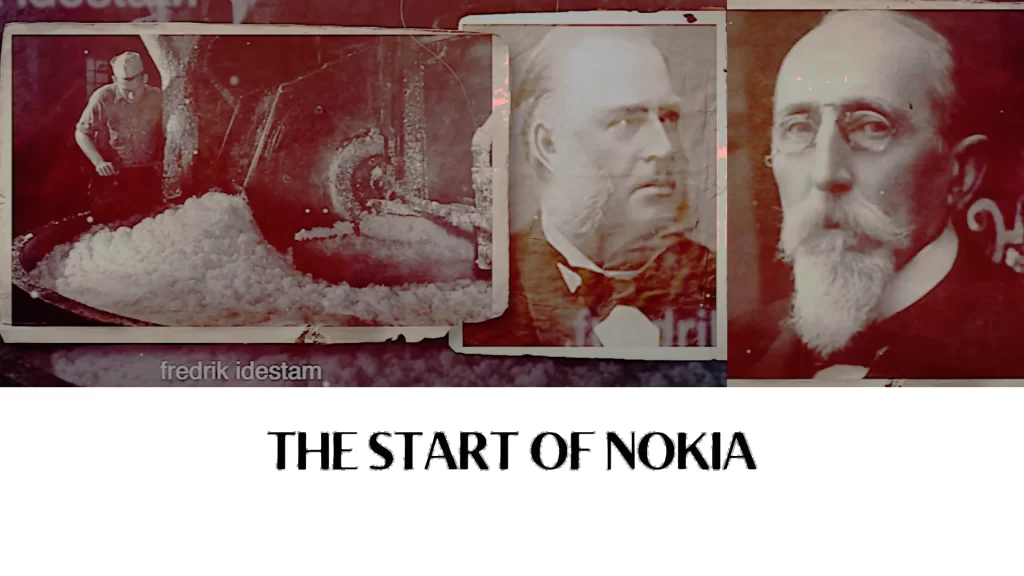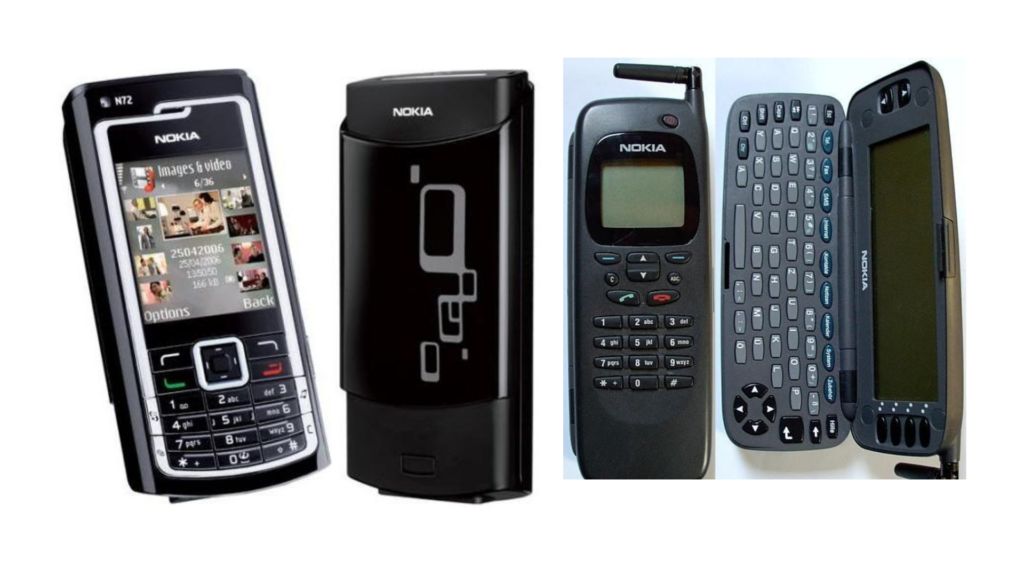Nokia was the company that introduced the portable mobile handset for the first time.
You will get shocked to know the world’s first SMS was ‘Merry Christmas’ sent from a Nokia phone.
Till 2005, Nokia captured the mobile world’s 70% market share.
And there was no company that could beat Nokia.
But the question is how did this powerful 50 Billion Dollar company fail?
Many people still think Nokia failed because of Apple and Google.
‘ Didn’t adapt Android so it failed.’
Well, this is not the case. Reality is different.
Shockingly, how did a company whose net worth was more than 50 Billion Dollars sold at 7 Billion Dollars only?
And most importantly what are those business lessons we can learn and implement in our business?
History of Nokia
So the story starts 150 years ago when Fredrik Idestam of Finland noticed that there’s a lot of forestry in Finland.
And after seeing this, he started a paper mill in Finland.
He takes the help of his friend Leo Macallan to expand the paper mill business.
Time by time, they expand and started many mills.
After starting many mills, they both decide to enter in Electricity Business.
They start an electricity generation plant near the bank of the Nokianvirta river and supplied electricity during World War.
from here they named ‘Nokia Ab’.
After World War, their business almost stopped as electricity demand was reduced.
from here only, Nokia decides to expand in various businesses.
then Nokia expanded into tubes, chemicals, plastics, and gas masks.

THE NOKIA TELEPHONES
then a major twist came into this story.
At that time, the Telephone was a luxury, and why not b’coz people neither had money nor resources.
And then finally in the 1960s, Nokia entered the telephone business.
At that time radio phones were used, were in cars or in the military.
Common people had no access to a telephone.
In the initial years, Nokia started working on its 1G network.
And launched their car phone mobile whose name was Mobira Senator.
But the problem was that the phone was 10 kgs so no one could use it anywhere except in cars.
After some time in 1987, Nokia finally launched their first portable phone – ‘Mobira Cityman’.
This 800 g phone is amazing but the common man could never afford it.
Interestingly, Mikhail Gorbachev – USSR’s President was spotted many times using a Mobirmobile phone.
And from here, Mobira became the symbol of power and status.
Many less of you would be knowing that the world’s first 2G call was done on a Nokia phone by Finland’s PM Harri Holkeri.

NOKIA MOBILES BOOM
And then in 1994, Nokia played a masterstroke.
At that time Nokia launched Nokia 2110 and they predicted 4 lakh orders of it but more than 2 Crore orders came.
Nokia boomed, and everyone said only about Nokia in the phone market.
And Yes, my first phone was from Nokia.
Now the question comes that why innovation king the f phone market – Nokia failed and could it have been stopped?
Yes, it could have been saved from falling. The question is How?
To understand this listen to these few things carefully.
2003-2005 were golden years for Nokia.
In these years only Nokia launched their Nokia 1100 and 1110.
These phones were ruling the market it wondered like they have won a lottery.
They were innovating daily.
There was such a storm in the market that 7 out of 10 phones which were sold were Nokia.
What Ericsson or Motorola Nokia ripped everyone.

NOKIA’S GOOD TIMES PASS BY
But then there was a big twist in the market.
That was a management turnaround.
Management Turnaround is considered to be good for most companies.
But proved very dangerous for Nokia.
Ex vice president Frank Nuovo of Nokia says that Nokia never lacked innovation
In fact, Nokia was the first one to develop the first Touchscreen Smart Phone and Tablet.
But management never permitted to launch of those in the market.
Now the question is Why?
The answer is hidden in the company’s decision-making process.
Now whenever Nokia has to take a decision regarding technology they used to approach the engineers b’coz finally, they have to develop the tech.
First, they used to take inputs from the tech team and then innovate those.
When the product was ready they used to launch or reject it according to their opinion.
There was a big gap in this process and that was Higher Orbit.
That means design thinking and this work was done by management, not the tech team.
But sadly half of the innovative decisions were taken by engineers in Nokia.
As long as management used to think and innovate meanwhile China used to develop and even sell the product.
Whatever changes in the business world but one truth never changes – It’s the people who build numbers.
This is where many people make mistakes. Employers make mistakes by hiring the wrong candidate.

Nokia Mobiles Hiring Plan
In 2006 when the management of Nokia was changed, at that time Nokia was running the N series flagship.
Then there was a huge explosion in the market.
In 2007 Steve announced that Apple is entering the mobile market.
iPhone was announced in front of the whole world.
At that time iPhone was no less than a revolutionary item for people.
Before launching iPhone in the market there were buttons or single touched phones.
But iPhone was the world’s first fully touched screen multi-touch phone.
Seeing this, why will Google remain silent.
Google launched Android.
To compete with these two Nokia launched NS800 which was a total hit.
After the launch of NS 800, then people agreed on one thing that
Nokia was the king of the market before and will continue to be.
But if everything was going so well then why no one from us doesn’t use a Nokia phone?
So the reason is Behavioural Shift.
So in every market, there is a time when the consumer starts getting bored with their things.
Now they need a change.
But in this also there is a twist.
New doesn’t mean innovative but something which gets them rid of the ongoing behaviour and builds something new.
Previously we used to make all transactions in cash.
Then PhonePe and PayTM hit the market.
There was no innovation but first, we used to carry cash now we carry phones.
The work of money is the same but your behaviour has been changed.
Similarly in those days, people got bored with featured phones.
No matter how good the hardware was, the software was exciting for the people.
Nokia’s phones were very good but because of slow software people started experiencing bad.
At the same time person using android or IOS was not facing any difficulty.
But why would Nokia give up?
Nokia wasn’t called the world’s biggest company like this.
To compete with android and IOS Nokia launched their own operating system named MEEGO OS.
Meego was so good that people started leaving Apple and android and started shifting to Nokia.
This move by Nokia shook the market.

Stephen Elop and Nokia Mobiles
Then enters Stephen Elop in this game.
Before joining Nokia from 2008 to 2010 Stephen Elop was MS office’s Internal Business Head in Microsoft.
In 2010 when Stephen joined Nokia, he first focused on research and innovation.
At that time Nokia used to spend 5 million dollars on research and innovation which was 30 % of the market.
He used to travel the world by saying that he was gathering the best technology for Nokia.
But there is a saying that when intentions are wrong then hard work has no value.
When Meego was going well, in Feb 2011 Stephen Elop met Steve Ballmer who was CEO of Microsoft.
Together they decided that Nokia will use Microsoft operating system on its phone.
This was ok but along with this, they discontinued Meego.
After Elop and Ballmer’s decision Nokia launched their Lumiya series.
But people were not liking it and the reason was Complexity.
I usually say that people don’t make good decisions but take convenient decisions.
Every person like their convenience and simple things, no one wants to take complex things.
And you already know how simple windows is on the phone.
By 2013 Nokia was going out of people’s hearts and minds.
Nokia had a 24 % revenue drop and a loss of more than 4 Billion $ yearly loss.
And then such a thing happened that Nokia could not rise from it.
On 3rd Sep 2012, Microsoft acquired Nokia for 7 Billion dollars.
Shockingly, how did a company whose net worth was more than 50 Billion Dollars sold at 7 Billion Dollars only?
So the reason is Dirty Politics.
At the time when Stephen Elop joined the company, Nokia didn’t make any profits.
So the question arises that despite being a competent man how was this going in the company?
A company which was more than 50 Billion dollars was made to get sold at 7 Billion dollars to Microsoft.
And after the company was sold he got a 19 Million Dollars Bonus.
From these 2 things, you can clearly identify Stephen Elop’s hidden agenda.
He didn’t want to grow Nokia but to sell the company to Microsoft and become CEO as Steve Ballmer was soon going to retire.
When Satya Nadella became Microsoft’s CEO, he clearly stated – ‘Microsoft’s biggest mistake was to acquire Nokia’
And then Satya Nadella sold Nokia to HMD Global and shifted to their core business.

The Nokia lessons
most importantly what is those business lessons we can learn and implement in our business?
1) Complexities can cause you a Fortune
The more complex things, the more time it takes to structure them.
Whether they are business processes or operating systems.
When business processes are complex it takes time in decision make.
And this same thing happened with Nokia.
When your product has many complexities and then if your competitor provides the same thing in a simple way then customers will shift.
And this is why I say – ‘People love to take Convenient Decisions’
And this brings us to 2nd business lesson.
2) Interdependency is better than moving alone
Samsung, Motorola, OnePlus, and Xiaomi are ripping off the market b’coz they adopted the Android ecosystem on time.
While Apple built such a strong ecosystem that once you buy Apple products then you will use Apple products only.
Nokia didn’t do anything from this, neither did they adapt to Android nor could create their own ecosystem.
But they could survive by creating interdependency.
This brings us to the most important lesson.
3) Character First and Competence Later
Whenever you hire an employee, see character first and competence later.
B’coz competence without character is very dangerous for the company.
Stephen Elop is a living example of it.
Competence was amazing but due to lack of character ruined the company.
One bad employee can destroy the whole company.
Most people hire the wrong candidate while hiring and I don’t want you to do this same mistake.
So during team building, it is important to hire the right candidate.




